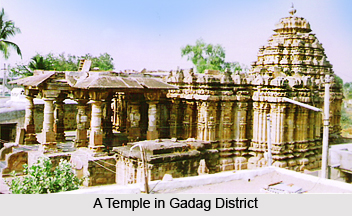 Gadag district is the birthplace of the first co-operative movement in Asia. Located in the western part of the state of Karnataka, Gadag district is primarily an agricultural district with a major portion of the population depending on the same for livelihood. Gadag district is a famous centre of Kalyani - Chalukya art. The Veera Narayana Temple and Someshwara Temple are excellent examples of the same.
Gadag district is the birthplace of the first co-operative movement in Asia. Located in the western part of the state of Karnataka, Gadag district is primarily an agricultural district with a major portion of the population depending on the same for livelihood. Gadag district is a famous centre of Kalyani - Chalukya art. The Veera Narayana Temple and Someshwara Temple are excellent examples of the same.
Gadag district is located in the Western part of Northern Karnataka. It lies between 14.52 North latitudinal parallels and 75.17 and 76.02 East longitudinal parallels. The district is bounded by six districts namely Dharwad district on West, Belgaum district on the North-West, Bagalkot district on the North, Koppal district on the East, Bellary district on the South East and Haveri district on the South-West. Malaprabha River in the North and the Tungabhadra River in the South form the natural boundaries.
Geography of Gadag District
Gadag district has an agreeable climate. The year is usually divided into four seasons. Summer sets in during the second half of February and lasts till the end of May. This season is marked by harsh eastern winds, rising temperatures, whirlwinds, and occasional thunderstorms accompanied by sharp showers. South-west monsoon season starts during early June and lasts till the end of September.
This is a period of cool and damp climate. The months of October and November constitute the post monsoon or the north-west monsoon season and this period witness a gradual rise in day temperatures and a substantial amount of rainfall as well. The winter season covers the period from December to mid February. The average maximum temperature of 37.3 C is in the month of April. December has the minimum temperature of 16.5 C.
Gadag district receives average annual rainfall of 612.5 mm. During the south west monsoon 56% of the annual rainfall precipitates. The district is deficient in forest wealth. Forest occupies about 7 percent of the total geographical area and a large part of it belongs to the shrub category. The district is also not rich in fauna.
 Demography of Gadag District
Demography of Gadag District
According to the Population of India in the Census in the year 2011, Gadag District had population of 1,065,235 of which male and female were 538,477 and 526,758 respectively. In 2001 census, this figure for Gadag District was at 1.84 percent of Maharashtra population.
The average literacy rate of Gadag in 2011 was 75.18 compared to 66.11 of 2001. If things are looked out at gender wise, male and female literacy were 84.89 and 65.29 respectively.
Economy of Gadag District
Gadag District is predominantly an agriculture-based district and cultivable land is the backbone of its economy. Agriculture contributes to about 65.5 percent of the income of the district. The main food crops are jowar, wheat, maize and pulses while the important commercial crops are groundnut, chillies, onion and cotton. The major horticultural crops grown in the district are pomegranate, chickoo and flower. Sericulture activity, though made a beginning, is yet to pick up in the district.
In the Gadag district, due to slow improvement in infrastructure, especially power and transport, industrial growth has been slow. The small scale industries in the district constituted about 1.9 percent of the total units in Karnataka. The district accounts for about 2.9 percent of small scale sector employment in the state. The per unit employment, investment in plant machinery, capacity utilization are also lower than the state average. Falling in line with the state, food and food processing industry provides the highest employment in the district followed by textiles, printing, metal products, machine tool, furniture and paper products. About 25 per cent of the workers are self employed in the district.
Tourism in Gadag District
Tourism in Gadag district involves visiting the various temples located here. One of the most beautiful temples in the district is the Veeranarayana temple, built by the rulers of the Hoysala Empire in 1117 A.D. The Dambala temple is located in Dambala, a place famous for its grapes and oranges. The Lord Shiva temple built here belongs to the Kalyani Chalukya period. Lakkundi was once an important centre for religious training. Many temples of the Kalyani Chalukya dynasty are still found here. Though many of them were destroyed during the invasion, they have been subsequently rebuilt. Thus lies Gadag, one of the many districts of Karnataka.






